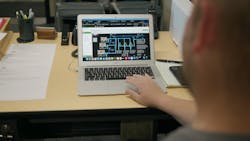Building Systems “Re-set”
On graduation day 2011, a cataclysmic tornado flattened much of Joplin, Missouri, wiping out the city’s high school and adjacent technical center. Undaunted, the city rebuilt. After three years in temporary campuses, the school opened a new 488,000 sq.-ft. building in September 2014 that houses both the high school and technical school.
Unfortunately, while the sparkling new building provided ample space, it proved to be an energy “hog,” generating unusually high energy costs. “We weren’t functioning as efficiently as we hoped that we would for a building this large and that new,” said Dave Pettit, Director of Facilities for Joplin Schools. Additionally, students, teachers and staff found that building comfort varied from room to room.
District leaders wanted to reduce the building’s energy and operational costs and address indoor air quality (IAQ) concerns while increasing staff productivity. Based on their more than 20-year relationship with Trane, they turned to consultants at the building technology and energy solutions company for answers.
Putting Data to Work
Trane experts recommended that the district start by conducting an Energy Assessment as part of an Intelligent Services approach. The Trane team put building data to work, using existing building sensors to measure facility-wide energy use and identify opportunities to save money, reduce energy consumption and optimize the building.
The Energy Assessment identified multiple issues:
- Overrides – In response to building complaints, staff had entered as many as 3,000 still-active system overrides, so the building operating schedule was no longer aligned with actual occupancy requirements. In some cases, overrides were causing heating and cooling to take effect at the same time.
- High CO2 – Some outside air dampers were stuck open or closed. Dampers that are stuck open generate hard-to-condition humidity or temperature ranges throughout the building. Closed dampers led to increased CO2 levels, even exceeding 2,000 parts per million (ppm) in some areas, well above the recommended level of 1,200.
An April 2020 analysis published in Building and Environment` found a relationship between reduced CO2 and improved student performance. The research concluded that reducing classroom CO2 from around 2,400 ppm to 900 ppm can be expected to improve children’s performance of national tests by about five percent.1
Recommissioning “Re-Sets” Building Systems
Based on Energy Assessment results, Trane recommended recommissioning the building’s infrastructure systems which assesses building systems and returns equipment as close as possible to its original design specifications. Once completed, recommissioning brings an entire system into better balance to improve overall building performance. Once the building was recommissioned Trane worked with staff to ensure that they were prepared to respond to any issues without overriding the system.
Recommissioning resolved the need to override the system since building temperature automatically adjusted in response to occupancy. The recommissioning also addressed issues with stuck dampers, helping ensure that CO2 levels remained at an appropriate level and optimized IAQ environmental conditions across the campus.
Intelligent Services Agreement Includes 24/7 Active Monitoring
Next, the district undertook Active Monitoring as part of an ongoing Intelligent Services agreement that allows the district to leverage Trane’s energy expertise to continuously optimize building conditions. The Service Agreement engages TraneAs part of the Active Monitoring process, Trane worked with the district to increase the number of building sensors. These sensors provide real-time information about temperature and IAQ, including humidity and CO2 levels. The sensors alert Trane and the facilities team when troubleshooting is needed. Once the issue is resolved, the building system accordingly adjusts future programming for continuous commissioning.
Results
Since district recommissioned the building and implemented Intelligent Services in 2018, building management has shifted from reactive to proactive, generating $200,000 in energy savings ($50,000/year) over the four years. With building comfort improved and complaints almost non-existing, facilities staff has increased productivity freeing up one FTE day per week. IAQ also has improved now that the building’s systems properly manage CO2 and humidity.
Based on the success of the improvements, Trane is currently working on building automation system upgrades that will further enhance building performance.
Case study by Trane. Used by permission. Trane.com

